BM565 Presentation: AI in ASDA, Digital Business & Technologies
VerifiedAdded on 2023/06/11
|10
|1012
|81
Presentation
AI Summary
This presentation summarizes the role of digital business and new technologies, particularly artificial intelligence (AI), within ASDA. It builds upon a previous report, highlighting AI's importance in demand projection, inventory management, waste reduction, and understanding consumer behavior. The presentation also touches upon the potential use of robots and AI-driven cleanliness monitoring. Innovation diffusion models, including Rogers' diffusion of innovation theory and Schumpeter's theory of innovation, are applied to understand the adoption and impact of AI within the organization and the broader sector. The conclusion reinforces the significance of digital technologies in modern business.

BM565 Digital Business
and New Technology
and New Technology
Paraphrase This Document
Need a fresh take? Get an instant paraphrase of this document with our AI Paraphraser
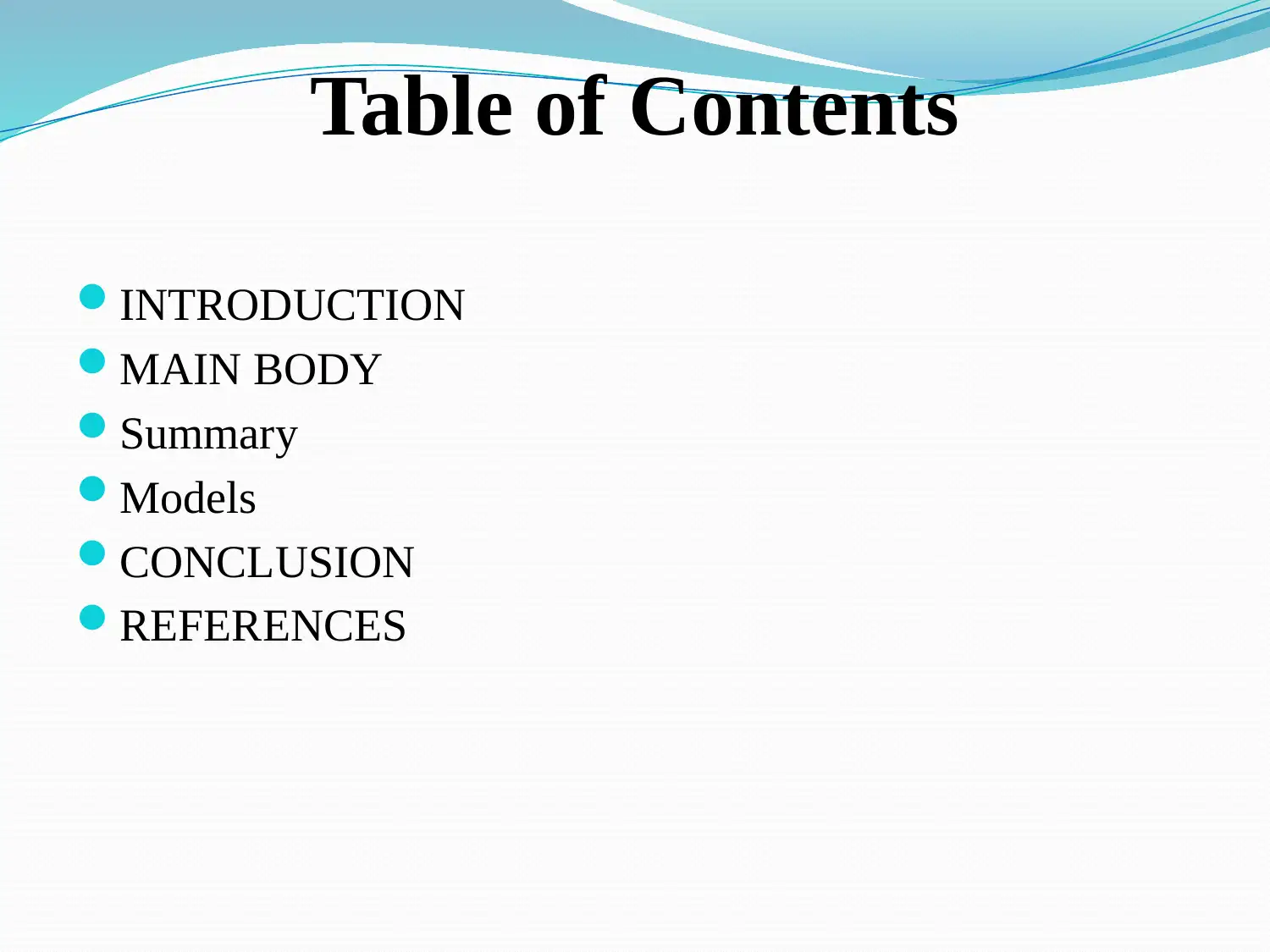
Table of Contents
INTRODUCTION
MAIN BODY
Summary
Models
CONCLUSION
REFERENCES
INTRODUCTION
MAIN BODY
Summary
Models
CONCLUSION
REFERENCES
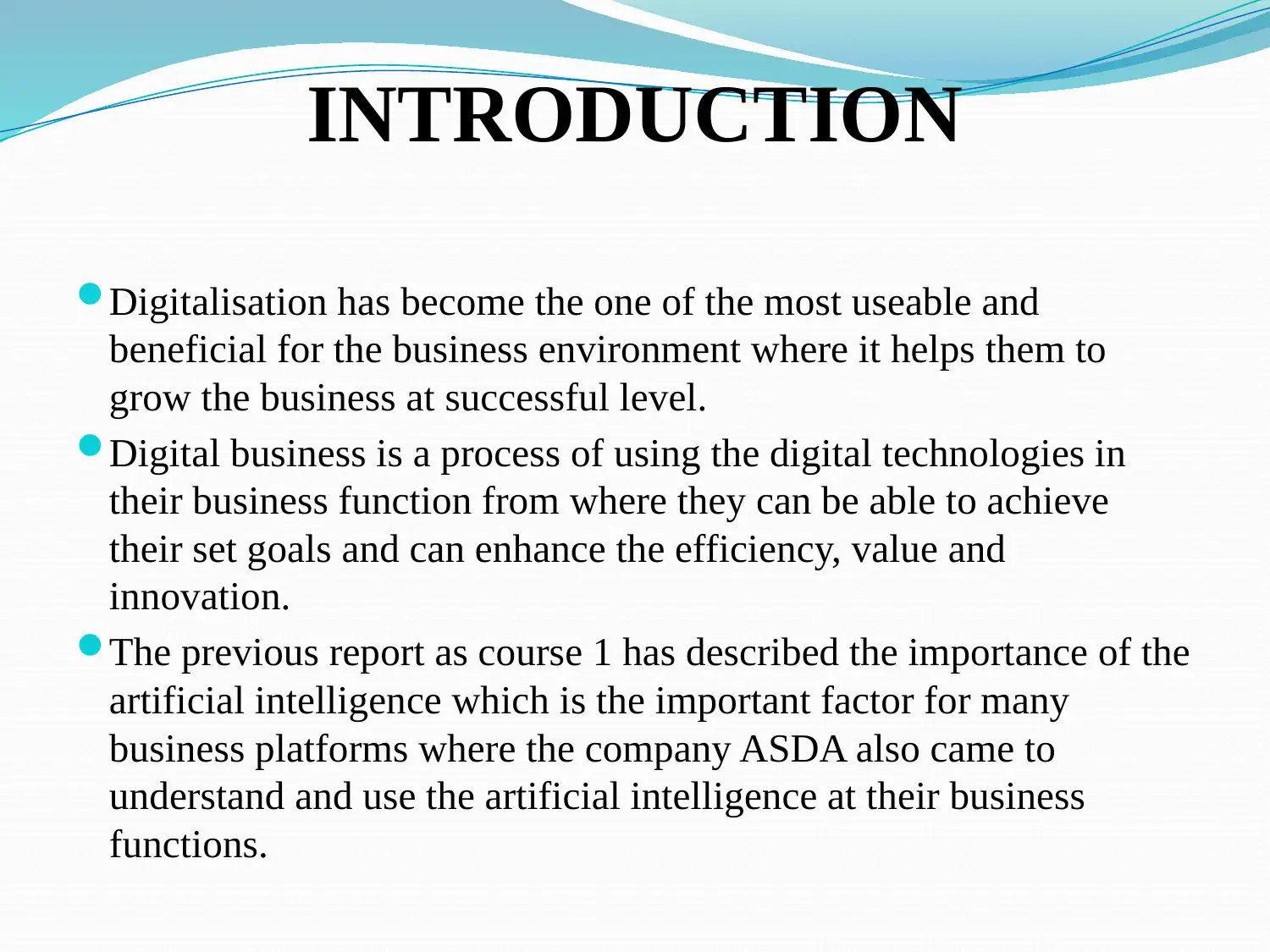
INTRODUCTION
Digitalisation has become the one of the most useable and
beneficial for the business environment where it helps them to
grow the business at successful level.
Digital business is a process of using the digital technologies in
their business function from where they can be able to achieve
their set goals and can enhance the efficiency, value and
innovation.
The previous report as course 1 has described the importance of the
artificial intelligence which is the important factor for many
business platforms where the company ASDA also came to
understand and use the artificial intelligence at their business
functions.
Digitalisation has become the one of the most useable and
beneficial for the business environment where it helps them to
grow the business at successful level.
Digital business is a process of using the digital technologies in
their business function from where they can be able to achieve
their set goals and can enhance the efficiency, value and
innovation.
The previous report as course 1 has described the importance of the
artificial intelligence which is the important factor for many
business platforms where the company ASDA also came to
understand and use the artificial intelligence at their business
functions.
⊘ This is a preview!⊘
Do you want full access?
Subscribe today to unlock all pages.

Trusted by 1+ million students worldwide
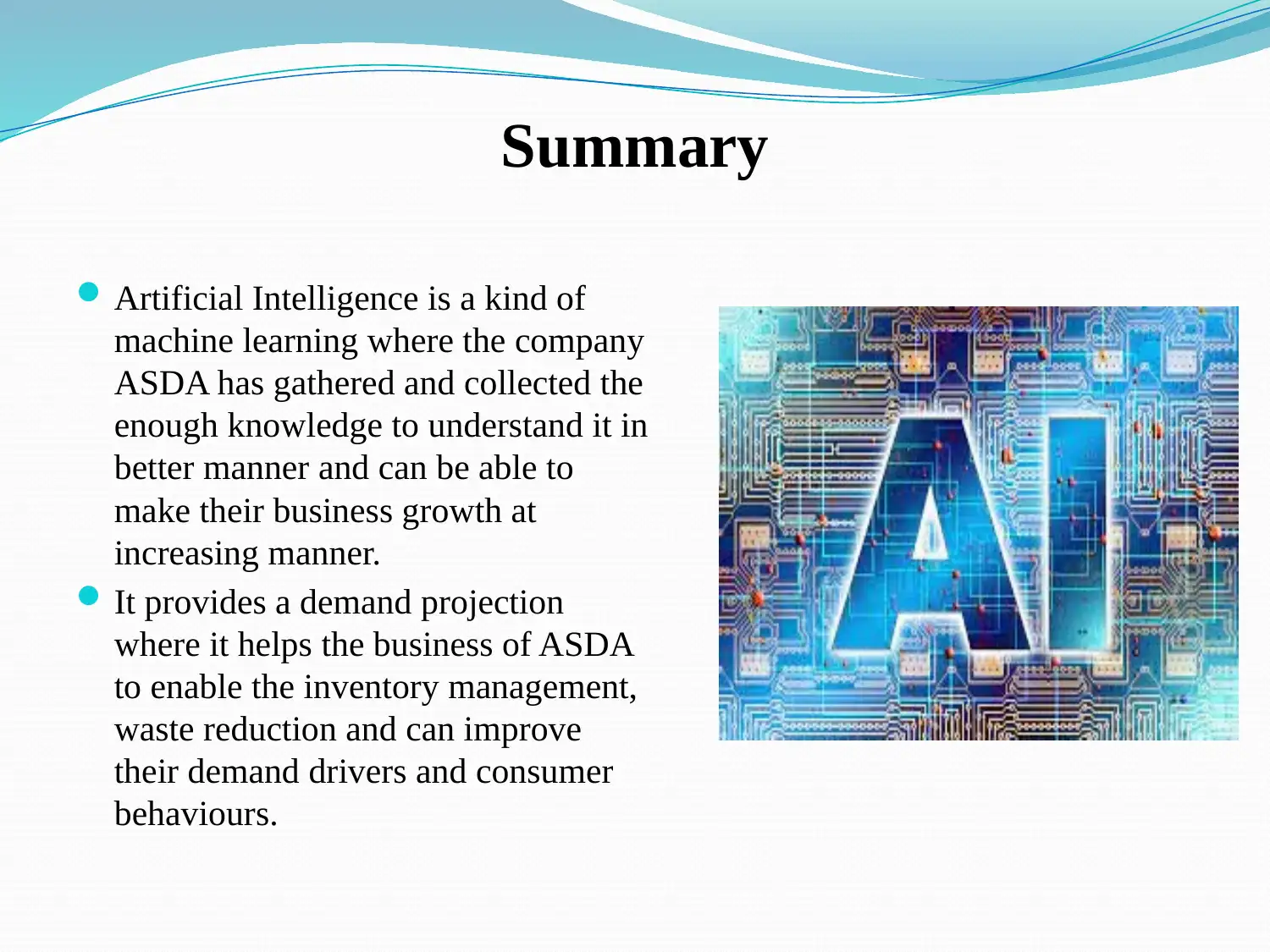
Summary
Artificial Intelligence is a kind of
machine learning where the company
ASDA has gathered and collected the
enough knowledge to understand it in
better manner and can be able to
make their business growth at
increasing manner.
It provides a demand projection
where it helps the business of ASDA
to enable the inventory management,
waste reduction and can improve
their demand drivers and consumer
behaviours.
Artificial Intelligence is a kind of
machine learning where the company
ASDA has gathered and collected the
enough knowledge to understand it in
better manner and can be able to
make their business growth at
increasing manner.
It provides a demand projection
where it helps the business of ASDA
to enable the inventory management,
waste reduction and can improve
their demand drivers and consumer
behaviours.
Paraphrase This Document
Need a fresh take? Get an instant paraphrase of this document with our AI Paraphraser
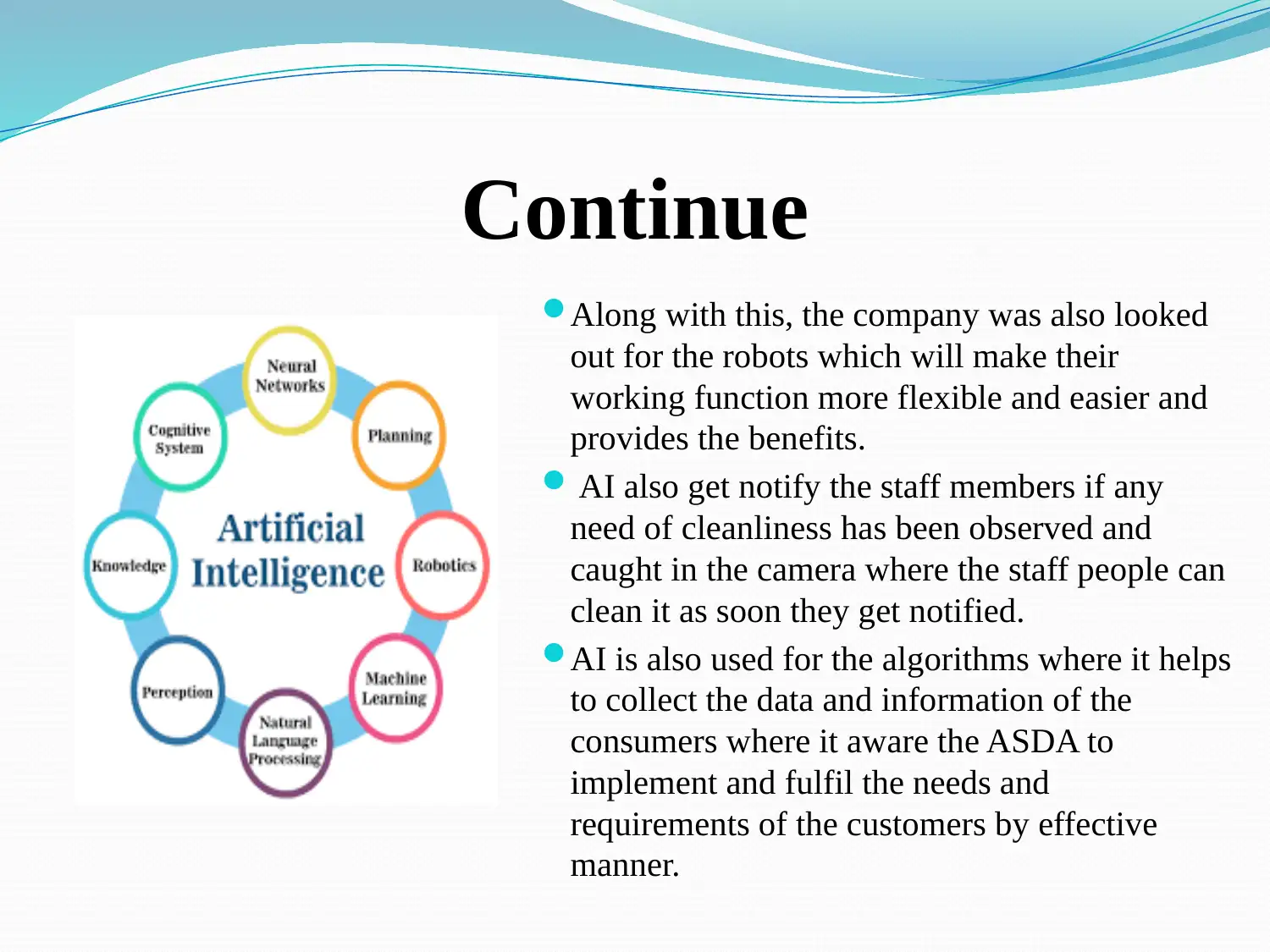
Continue
Along with this, the company was also looked
out for the robots which will make their
working function more flexible and easier and
provides the benefits.
AI also get notify the staff members if any
need of cleanliness has been observed and
caught in the camera where the staff people can
clean it as soon they get notified.
AI is also used for the algorithms where it helps
to collect the data and information of the
consumers where it aware the ASDA to
implement and fulfil the needs and
requirements of the customers by effective
manner.
Along with this, the company was also looked
out for the robots which will make their
working function more flexible and easier and
provides the benefits.
AI also get notify the staff members if any
need of cleanliness has been observed and
caught in the camera where the staff people can
clean it as soon they get notified.
AI is also used for the algorithms where it helps
to collect the data and information of the
consumers where it aware the ASDA to
implement and fulfil the needs and
requirements of the customers by effective
manner.
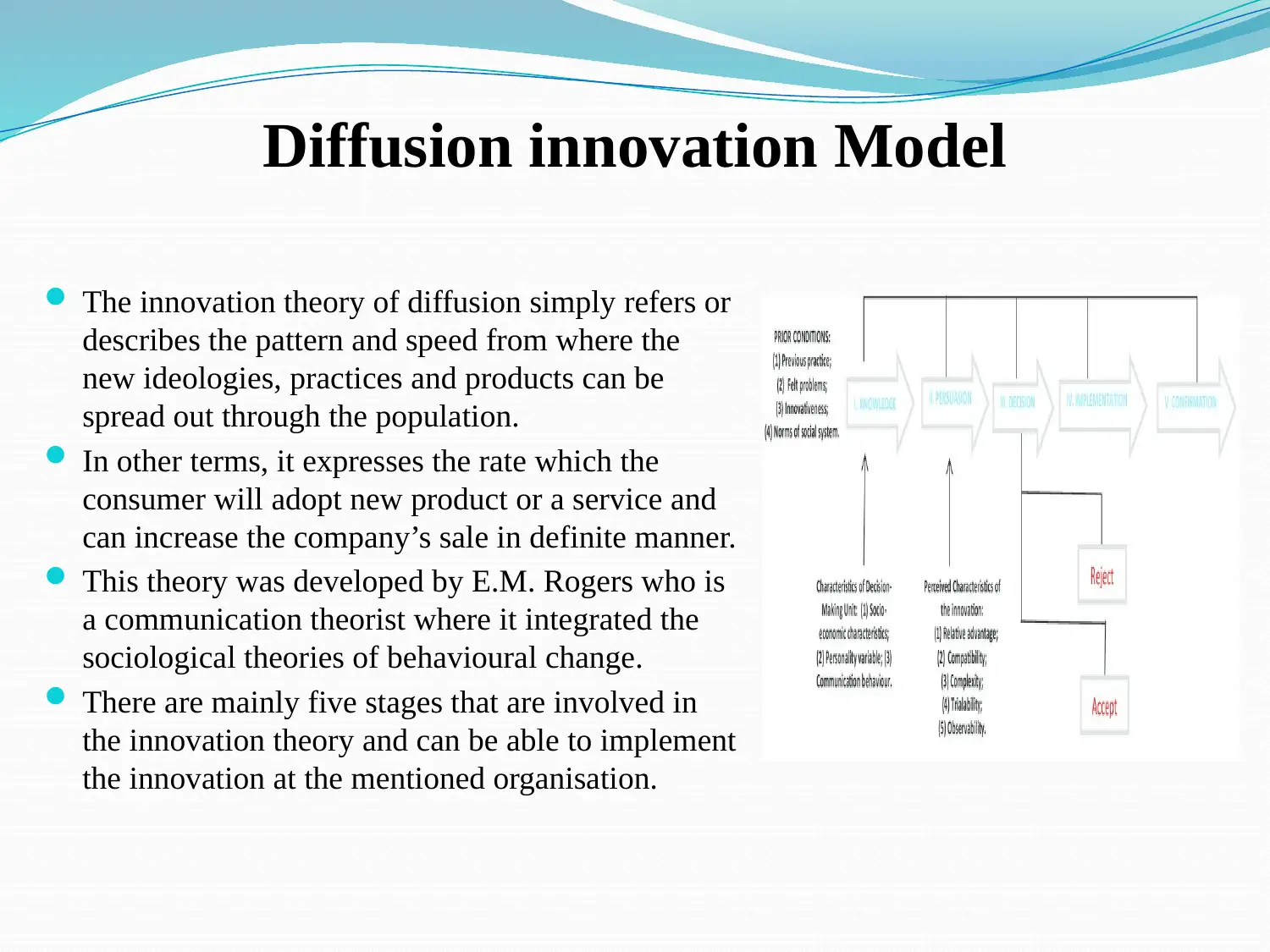
Diffusion innovation Model
The innovation theory of diffusion simply refers or
describes the pattern and speed from where the
new ideologies, practices and products can be
spread out through the population.
In other terms, it expresses the rate which the
consumer will adopt new product or a service and
can increase the company’s sale in definite manner.
This theory was developed by E.M. Rogers who is
a communication theorist where it integrated the
sociological theories of behavioural change.
There are mainly five stages that are involved in
the innovation theory and can be able to implement
the innovation at the mentioned organisation.
The innovation theory of diffusion simply refers or
describes the pattern and speed from where the
new ideologies, practices and products can be
spread out through the population.
In other terms, it expresses the rate which the
consumer will adopt new product or a service and
can increase the company’s sale in definite manner.
This theory was developed by E.M. Rogers who is
a communication theorist where it integrated the
sociological theories of behavioural change.
There are mainly five stages that are involved in
the innovation theory and can be able to implement
the innovation at the mentioned organisation.
⊘ This is a preview!⊘
Do you want full access?
Subscribe today to unlock all pages.

Trusted by 1+ million students worldwide
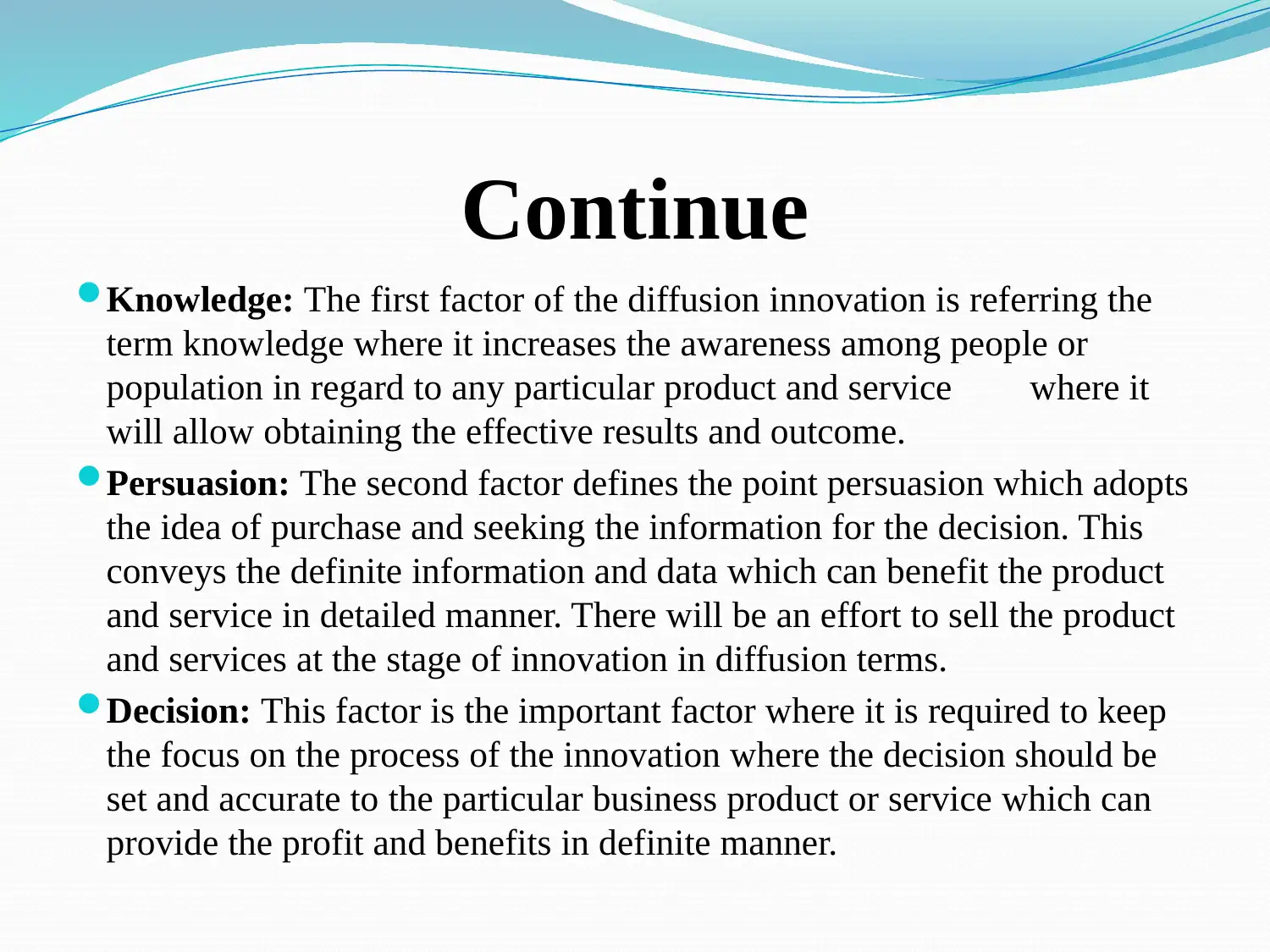
Continue
Knowledge: The first factor of the diffusion innovation is referring the
term knowledge where it increases the awareness among people or
population in regard to any particular product and service where it
will allow obtaining the effective results and outcome.
Persuasion: The second factor defines the point persuasion which adopts
the idea of purchase and seeking the information for the decision. This
conveys the definite information and data which can benefit the product
and service in detailed manner. There will be an effort to sell the product
and services at the stage of innovation in diffusion terms.
Decision: This factor is the important factor where it is required to keep
the focus on the process of the innovation where the decision should be
set and accurate to the particular business product or service which can
provide the profit and benefits in definite manner.
Knowledge: The first factor of the diffusion innovation is referring the
term knowledge where it increases the awareness among people or
population in regard to any particular product and service where it
will allow obtaining the effective results and outcome.
Persuasion: The second factor defines the point persuasion which adopts
the idea of purchase and seeking the information for the decision. This
conveys the definite information and data which can benefit the product
and service in detailed manner. There will be an effort to sell the product
and services at the stage of innovation in diffusion terms.
Decision: This factor is the important factor where it is required to keep
the focus on the process of the innovation where the decision should be
set and accurate to the particular business product or service which can
provide the profit and benefits in definite manner.
Paraphrase This Document
Need a fresh take? Get an instant paraphrase of this document with our AI Paraphraser
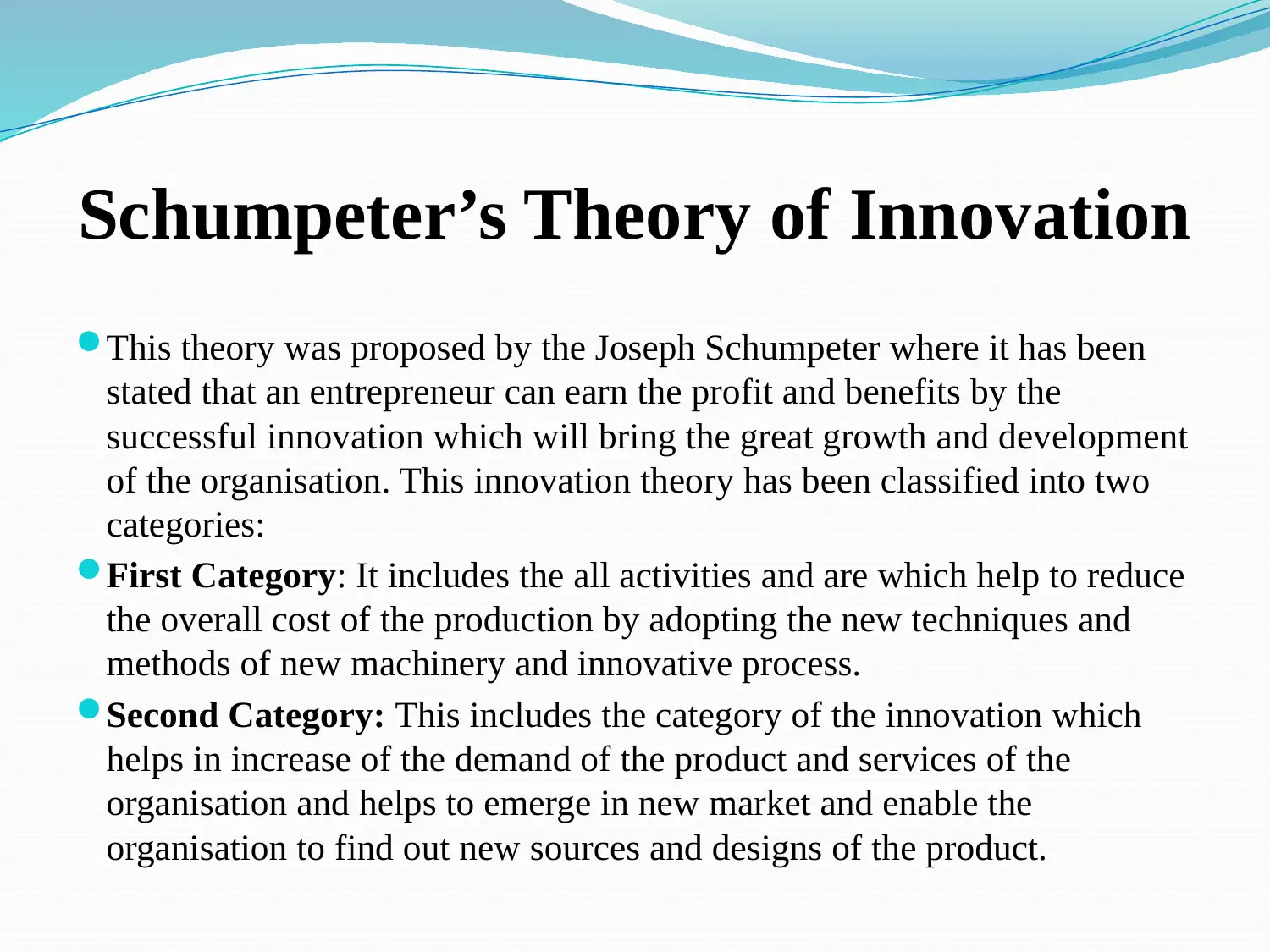
Schumpeter’s Theory of Innovation
This theory was proposed by the Joseph Schumpeter where it has been
stated that an entrepreneur can earn the profit and benefits by the
successful innovation which will bring the great growth and development
of the organisation. This innovation theory has been classified into two
categories:
First Category: It includes the all activities and are which help to reduce
the overall cost of the production by adopting the new techniques and
methods of new machinery and innovative process.
Second Category: This includes the category of the innovation which
helps in increase of the demand of the product and services of the
organisation and helps to emerge in new market and enable the
organisation to find out new sources and designs of the product.
This theory was proposed by the Joseph Schumpeter where it has been
stated that an entrepreneur can earn the profit and benefits by the
successful innovation which will bring the great growth and development
of the organisation. This innovation theory has been classified into two
categories:
First Category: It includes the all activities and are which help to reduce
the overall cost of the production by adopting the new techniques and
methods of new machinery and innovative process.
Second Category: This includes the category of the innovation which
helps in increase of the demand of the product and services of the
organisation and helps to emerge in new market and enable the
organisation to find out new sources and designs of the product.
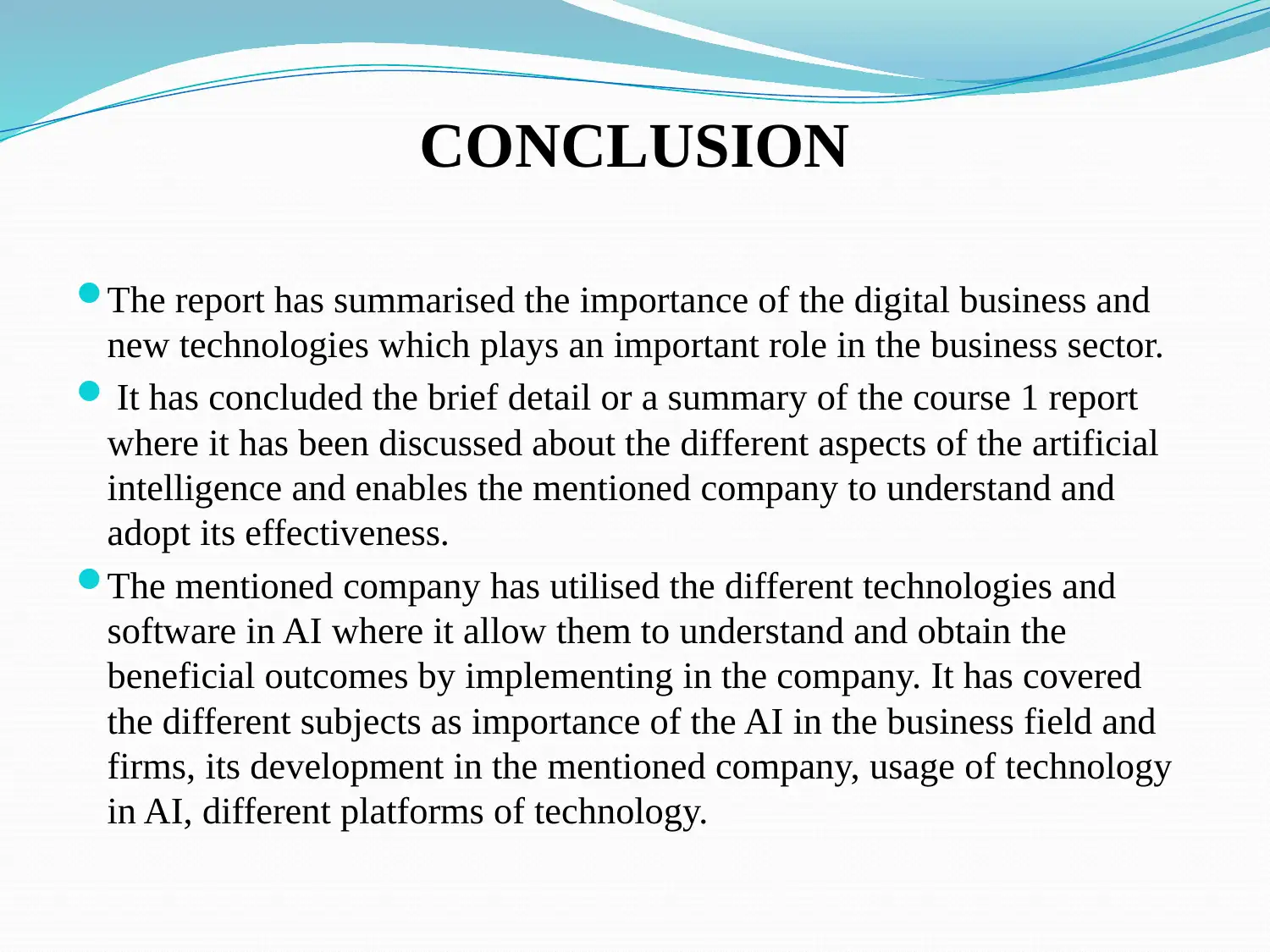
CONCLUSION
The report has summarised the importance of the digital business and
new technologies which plays an important role in the business sector.
It has concluded the brief detail or a summary of the course 1 report
where it has been discussed about the different aspects of the artificial
intelligence and enables the mentioned company to understand and
adopt its effectiveness.
The mentioned company has utilised the different technologies and
software in AI where it allow them to understand and obtain the
beneficial outcomes by implementing in the company. It has covered
the different subjects as importance of the AI in the business field and
firms, its development in the mentioned company, usage of technology
in AI, different platforms of technology.
The report has summarised the importance of the digital business and
new technologies which plays an important role in the business sector.
It has concluded the brief detail or a summary of the course 1 report
where it has been discussed about the different aspects of the artificial
intelligence and enables the mentioned company to understand and
adopt its effectiveness.
The mentioned company has utilised the different technologies and
software in AI where it allow them to understand and obtain the
beneficial outcomes by implementing in the company. It has covered
the different subjects as importance of the AI in the business field and
firms, its development in the mentioned company, usage of technology
in AI, different platforms of technology.
⊘ This is a preview!⊘
Do you want full access?
Subscribe today to unlock all pages.

Trusted by 1+ million students worldwide
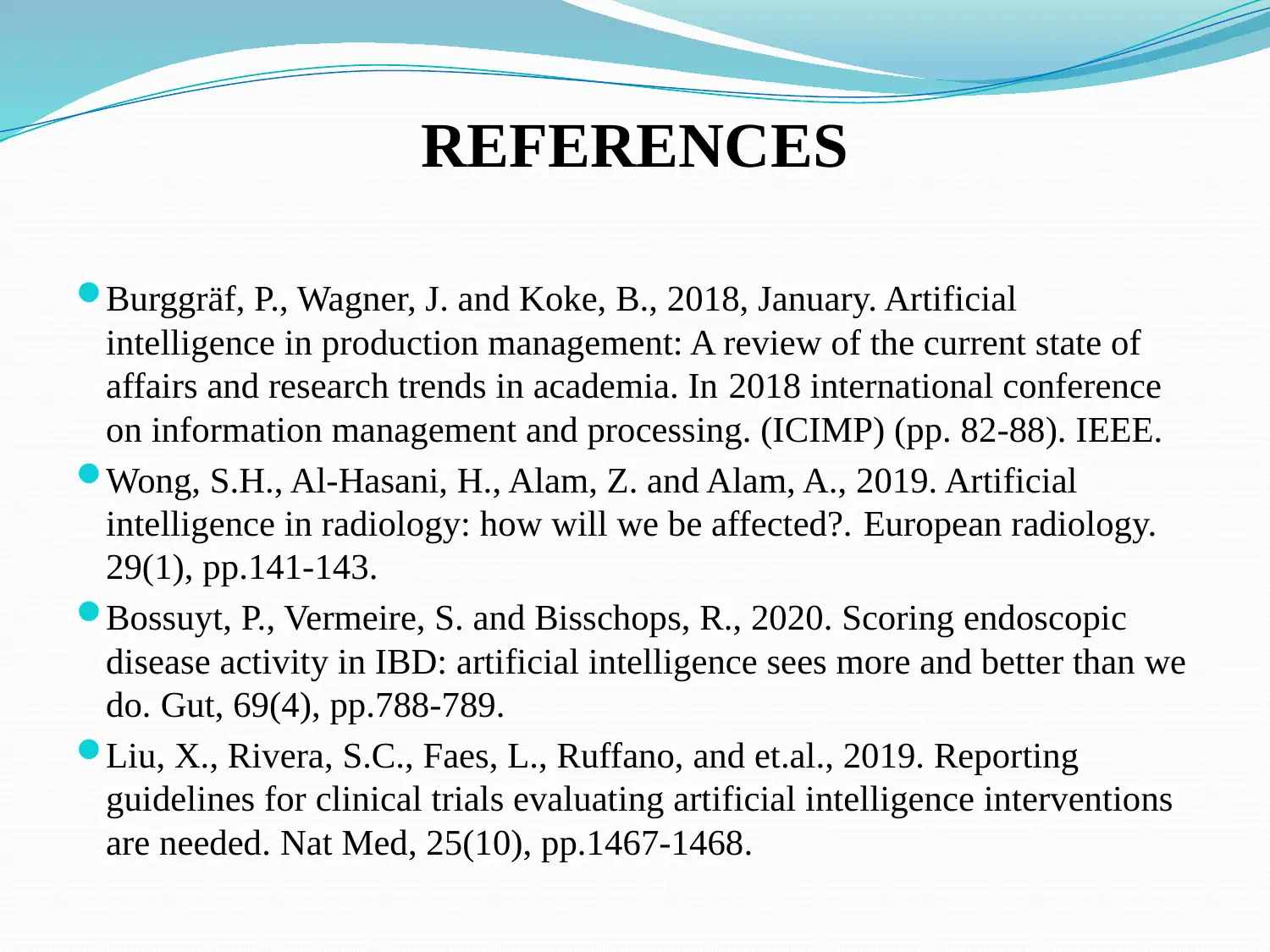
REFERENCES
Burggräf, P., Wagner, J. and Koke, B., 2018, January. Artificial
intelligence in production management: A review of the current state of
affairs and research trends in academia. In 2018 international conference
on information management and processing. (ICIMP) (pp. 82-88). IEEE.
Wong, S.H., Al-Hasani, H., Alam, Z. and Alam, A., 2019. Artificial
intelligence in radiology: how will we be affected?. European radiology.
29(1), pp.141-143.
Bossuyt, P., Vermeire, S. and Bisschops, R., 2020. Scoring endoscopic
disease activity in IBD: artificial intelligence sees more and better than we
do. Gut, 69(4), pp.788-789.
Liu, X., Rivera, S.C., Faes, L., Ruffano, and et.al., 2019. Reporting
guidelines for clinical trials evaluating artificial intelligence interventions
are needed. Nat Med, 25(10), pp.1467-1468.
Burggräf, P., Wagner, J. and Koke, B., 2018, January. Artificial
intelligence in production management: A review of the current state of
affairs and research trends in academia. In 2018 international conference
on information management and processing. (ICIMP) (pp. 82-88). IEEE.
Wong, S.H., Al-Hasani, H., Alam, Z. and Alam, A., 2019. Artificial
intelligence in radiology: how will we be affected?. European radiology.
29(1), pp.141-143.
Bossuyt, P., Vermeire, S. and Bisschops, R., 2020. Scoring endoscopic
disease activity in IBD: artificial intelligence sees more and better than we
do. Gut, 69(4), pp.788-789.
Liu, X., Rivera, S.C., Faes, L., Ruffano, and et.al., 2019. Reporting
guidelines for clinical trials evaluating artificial intelligence interventions
are needed. Nat Med, 25(10), pp.1467-1468.
1 out of 10
Related Documents
Your All-in-One AI-Powered Toolkit for Academic Success.
+13062052269
info@desklib.com
Available 24*7 on WhatsApp / Email
![[object Object]](/_next/static/media/star-bottom.7253800d.svg)
Unlock your academic potential
Copyright © 2020–2025 A2Z Services. All Rights Reserved. Developed and managed by ZUCOL.





